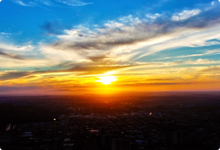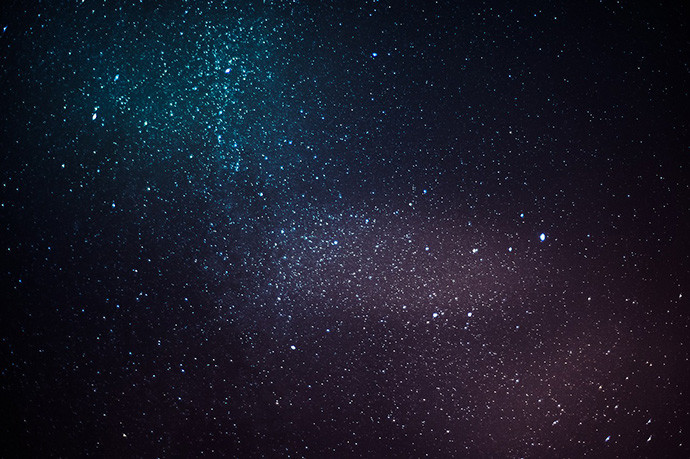Keep Looking Up
Ever since I was young, I shared a love of astronomy with my dad. Looking at the stars was a way to see beauty in the world, organization amid the chaos, possibility in spite of all prevailing notions of “this is right and true.” Stargazing allows for us to feel big and small at the same time: we are just a blip on the universal radar—our everyday banal troubles are self-created and unimportant—yet we are precious; we are significant. We have yet to find life elsewhere in the cosmos. This doesn’t mean it doesn’t exist, but it does show that it’s not a common commodity, and we should cherish ours all the more.
Stargazing also allows us to connect with each other, to tell stories that span cultures and continents and make sense of the world around us. Even now, when such explanations aren’t needed, we can use them to link our thoughts and hearts with those not present. When my dad left home, we knew that when we both looked up at the night sky and saw Orion (our favorite constellation), we were looking up at the same stars and thinking of each other. He ended every conversation with, “Keep looking up.” Now that he’s since passed, this connection has become so much more powerful. Every time I see Orion, I whisper, “Hi, Daddy. I love you. I miss you,” and my words float up to the heavens.
With all of this wonder and beauty just a neck-crane away, I’m amazed by how so few people revel in night-sky illuminations. On August 12, I was on an evening plane flight from Wisconsin back to New Jersey, and I was thrilled at the notion of being above the clouds at night. I typically fly first thing in the morning to beat out crowds and delays (and this flight wound up being delayed an hour), so this was a rare treat. I grew up (and still live in) light pollution-affected areas of NJ, so my night sky has never been particularly dark or spectacular. For all my astronomy love, my knowledge of the summer sky is also woefully lacking, because NJ in the summer has a serious humidity problem. Stargazing attempts have often been met with too much haze and too many clouds.
It was everything I expected it to be: beautiful, brilliant…black. Now, I’ve been to remote areas where I’ve had much better views of the night sky than at home—just recently, an absolutely crystal-clear night in the Poconos where I saw “shooting stars” (a more descriptive term for meteors) streaking across the sky and satellites orbiting Earth—but this was beyond. Flying several thousand feet up in the atmosphere makes the stars and satellites larger and more present than you’d experience anywhere on Earth. The only negatives were: one, the plane cabin lights interfered by casting reflections on the window, and two, that my flight wasn’t delayed a little bit more. We were flying just as the Perseid meteor shower was supposed to peak, and I was staring straight at Perseus the entire time. It would have been spectacular to see that display, but whether or not we flew slightly ahead of it or the difficulties in keeping a focused eye out the window for the entire flight (with all the reflections) kept me from seeing meteors, I didn’t see the light show I was hoping for. [I did, however, find a dark spot the next night to bask in this yearly phenomenon.]
What struck me the most about this flight was that so few people were looking out the window. People were sleeping, people were reading, people were on their computers and tablets and phones. People were using their ideal window seats as nothing more than head rests. Never mind that a potential meteor shower was about to happen and we were in a prime viewing spot, because not everyone knows about those things. The stars are out every night, however. Earth is lit on its surface by mankind, creating its own beauty when viewed from above. Here we were, in the middle of these two worlds, with ready capacity to marvel at both the above and below, the natural and the manmade. And no one was looking at it.
The surface is what surprised me the most; I had expected spectacular stars. The patterns and colors that our constructions give off, however, was intricately beautiful. The large geometric shapes that citywide infrastructure forms and the smaller hieroglyphs from lit housing developments seemed like symbols to the stars, us crafting messages to the great beyond. Sure, we can download Google Earth and see a bird’s-eye view of much of our planet nowadays, but unless you’re viewing the surface in real time, at night, you’re missing out on the interplay and variance of light, the way passing cars through an intersection can make that one spot pulse with rhythmic glow. The flickering intensity of lights dancing to the beat of an unheard song; the civilized music of our sphere.
We take beauty for granted; we take nature for granted. Sometimes we just need to look beyond our own little existences and be in awe of the world around us. Keep looking up, and down, and all around. Experience the world around you; don’t just sit idly by as it passes unnoticed and under-appreciated. As Carl Sagan once said, “We are a way for the cosmos to know itself.” I also think, in doing so, we learn a little more about ourselves, too.


